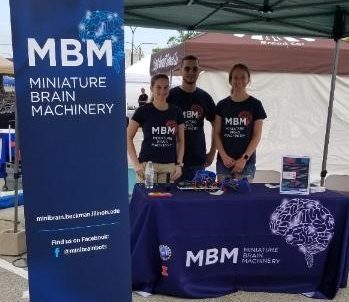 Karla Ramos-Cruz joined the program as a first-year graduate student in May 16, 2018 and is expected to graduate in 2022. Her major is bioengineering and she completed her undergraduate degree in chemical engineering at the University of Puerto Rico-Mayagüez. She is the first in her family to attend college. Her research topic is neuroengineering. Karla Ramos-Cruz was awarded a Support-Under-Represented-Groups-Engineering (SURGE) fellowship from the College of Engineering during her first academic year in graduate school. Consequently, she began in the NRT program at the end of the Spring semester.
Karla Ramos-Cruz joined the program as a first-year graduate student in May 16, 2018 and is expected to graduate in 2022. Her major is bioengineering and she completed her undergraduate degree in chemical engineering at the University of Puerto Rico-Mayagüez. She is the first in her family to attend college. Her research topic is neuroengineering. Karla Ramos-Cruz was awarded a Support-Under-Represented-Groups-Engineering (SURGE) fellowship from the College of Engineering during her first academic year in graduate school. Consequently, she began in the NRT program at the end of the Spring semester.
Ramos-Cruz has presented her research on training motor neurons at the Cellular Molecular Bioengineering Conference (2019), the Sloan UCEM Mini-Conference (2019), the MBM Retreat (2018 & 2019), and the Emergent Behavior of Integrated Cellular Systems (EBICS) Retreat (July 2019). She co-authored a paper on “Engineering geometrical 3-dimensional untethered in vitro neural tissue mimic” in PNAS (December 2019) and has collaborated with other trainees and faculty on additional papers and abstracts. She is completing lab rotations in the Gillette, Kong, and Bashir labs.

Ramos-Cruz has participated in other trainee activities such as the Summer Journal Club readings/discussion meetings, Frontiers in Miniature Brain Machinery lectures, and the MBM Retreat. She served on the MBM Student Leadership Council (2019-2020) and assisted with the MBM booth at the Urbana Farmer’s Market (June 2019). She volunteered to coordinate MBM booths for the 2020 Engineering Open House and Urbana Farmer’s Market, though those plans were canceled due to the COVID-19 pandemic. Her other outreach activities include serving as social chair for the GradBMES UIUC Chapter (2018-present) and mentoring three undergraduate students (2019-20).
Ramos-Cruz has completed four semesters of the Special Topics in MBM course plus coursework in cell & molecular neuroscience, integrative neuroscience, neurons & gliax, multiple topics in bioengineering and stem cells, advanced bioinstrumentation, quantitative biotechnology, written & oral communication, and bioengineering professionalism. She has also attended workshops on M-cells (July 2018) responsible conduct of research (January 2020), and “Teamwork, Communication, and Research Integrity” (February 2020).

Research Highlights (in her own words):
During the Fall of 2020, we engineered an in vitro neuronal model to study the role of microglia and how they can modulate electrophysiological behavior in human induced Pluripotent Stem Cells (hiPSC) derived cortical neuronal network during development. We characterized the cell population and functionality of neurons and microglia in culture and on a microelectrode array (MEA). The Real Time Quantitative Reverse Transcription (qRT-PCR) showed that we differentiated into a mixture of excitatory and inhibitory neurons that belong to the cortex. This was supported by the immunocytochemistry (ICC) of T-Box Brain Transcription Factor 1 (TBR1) a characteristic protein of the cerebral cortex. Importantly, our initial MEA data suggests that electrical activity of cortical neurons increased when co-cultures were performed in the presence of microglia.
Engineering in-vitro nerve tissue using hESC-derived neurons
In my research and from summer 2019 to spring 2020, I successfully started incorporating human stem cells in our lab and neuroscience related research. Now that we know that we can create an in vitro nerve tissue using murine source and we found very interesting results. Then, the next step is to start incorporating human stem cells to our models in order to increase the biomedical relevance. With the in vitro human nerve tissue, we observed similar hallmarks from the murine model such as tissue compaction and ECM secretion. Also, MEA recording showed electrical functionality of the human stem cells derived-neurons. Additionally, the human stem cells derived-neurons responded to excitatory and inhibitory treatments when we used neurotransmitters such as glutamate and GABA.
How has the traineeship benefited me?
Outside of experiments and results, this semester I started collaborating with another trainee, Jorge Maldonado. This was possible because of the MBM training grant. This is such a great opportunity that is allowing me to interact with other students and labs. Besides the contribution to the growing of my interpersonal skills, having a collaboration with Jorge bring the possibility of writing a manuscript and explore a new area within the Neuroscience Field. Jorge has more expertise with microscopes and imaging, while in my case I have more experience with stem cells, neuronal differentiation, microglia and tissue engineering in general.
Thanks to the MBM exchange we are joining efforts and labs to study and start a new and very interesting project. With his expertise in imaging we will be able to explore the role of microglia in the neuronal structure. Specifically, we think if microglia are co-culture with cortical neurons since day 0 of maturation, this will speed up the stabilization of the neuronal network. While if microglia are added after neuronal network is been stablished, this will change and remodel the structure of the neuronal network. With the expertise of Jorge using microscopes and tools to analyze images we will be able to increase or understanding about microglia and how they remodel human neuronal network in vitro. Finally, I am very excited about this collaboration and all the benefits that is bringing to my research and as a person.
On the other hand, I submitted an abstract to BMES 2020 Conference and was accepted. Then, thanks to the MBM Grant I was able to participate and present my research at this Virtual Conference. It was a great and very impressive experience. I was so amazed of how the online platform was so organized. It has so many things, but at the same time it was relatively easy to follow. I think for future conferences besides having “in person” interaction they should keep open the option and offer the opportunity to participate in the conference online as well (for those persons that can’t travel for any specific reason). Of course, I missed getting some “goodies” from the boost and exploring a new place. But at least I was able to share my research and knowledge with the scientific community which is one of the main goals of being a scientist.
Therefore, MBM Grant helps me to achieve a very important aspect of being a scientist, which is divulgate research and findings with the community. Also, most of the time what are the scientists currently doing it’s more advanced of what they published in their recent paper. Going to a conference gives me the opportunity to know what is cutting edge and what the scientists are currently studying in a closer real time.

